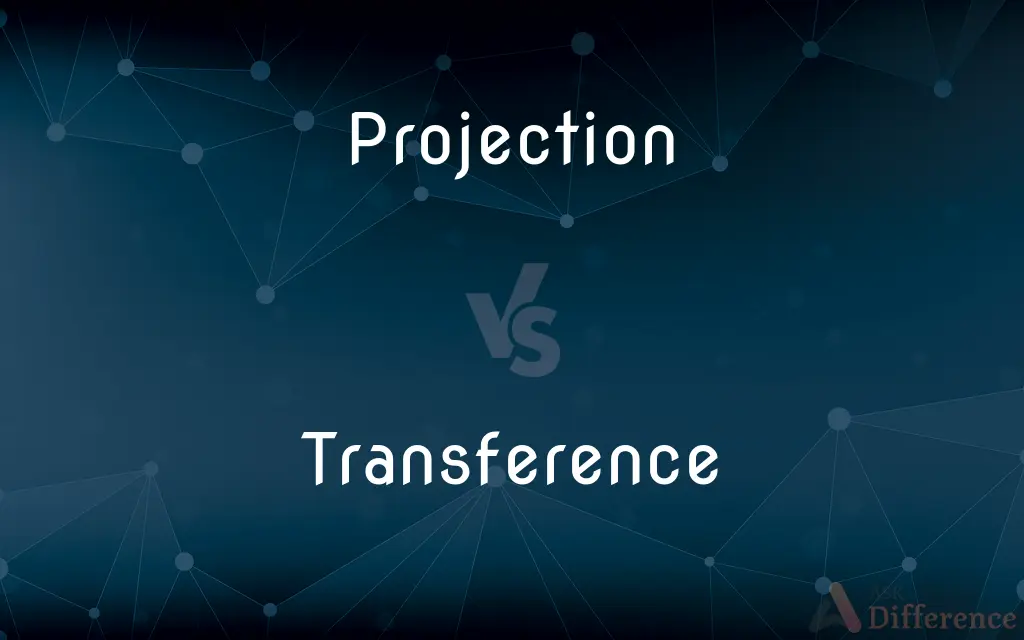Projection vs. Transference — What's the Difference?
By Tayyaba Rehman & Urooj Arif — Updated on February 24, 2024
Projection involves attributing one's own feelings onto someone else, often unconsciously, to avoid facing them. Transference is the redirection of feelings and attitudes from one person to another, particularly in therapy, based on past experiences.

Difference Between Projection and Transference
Table of Contents
ADVERTISEMENT
Key Differences
Projection is a defense mechanism where individuals unconsciously externalize their own undesirable emotions, desires, or thoughts, attributing them to others. For example, someone feeling hostile might accuse others of being hostile towards them, thus avoiding acknowledgment of their own negative feelings.
Transference, on the other hand, occurs when individuals redirect feelings and attitudes from past relationships onto someone in the present, often observed in therapeutic settings. A client may transfer feelings associated with a parent onto their therapist, thereby reenacting past dynamics in the therapy room.
Projection primarily serves as a way to defend against internal conflict by denying and attributing one's own uncomfortable qualities to others, while transference is rooted in unresolved issues and relationships from the past. This makes transference particularly valuable in psychotherapy, as it can reveal unresolved conflicts and facilitate their resolution.
Both processes are largely unconscious and stem from the individual's internal world, but their implications and the contexts in which they are most relevant differ significantly. Projection is more about dealing with personal acceptability of thoughts and emotions, while transference is about the reliving and potentially resolving of past relational dynamics. Understanding these mechanisms is crucial in psychotherapy and personal relationships, as they can significantly impact interpersonal dynamics and personal well-being.
Both projection and transference involve the redirection of feelings from oneself to others, but they differ in their origins, purposes, and implications. Projection is about self-protection and avoidance, whereas transference is about the re-experience and potential healing of past relational wounds.
ADVERTISEMENT
Comparison Chart
Definition
Attributing one's own unacceptable feelings or thoughts to others.
Redirecting feelings from one person to another based on past experiences.
Purpose
To defend against internal conflict and avoid facing personal faults.
To reenact and potentially resolve past relational dynamics.
Context
Common in everyday interpersonal interactions.
Often observed in therapeutic settings or close relationships.
Underlying Process
Denial of one's own qualities and attributing them to others.
Reliving past experiences and emotions in current relationships.
Therapeutic Relevance
Understanding projection can help in recognizing personal biases and conflicts.
Transference is a key concept in psychotherapy, providing insights into unresolved issues.
Compare with Definitions
Projection
Denying one's own negative traits and ascribing them to others.
Accusing others of being angry when one is feeling anger themselves.
Transference
Redirecting past feelings to a therapist or significant other.
Feeling parental authority from a boss and reacting based on childhood experiences.
Projection
A defense mechanism to avoid self-blame.
A jealous person might claim that others are jealous of them.
Transference
A key concept in psychoanalysis.
The therapist recognized the patient's transference as a replay of his childhood conflicts.
Projection
Often occurs unconsciously.
Without realizing it, he projected his fears onto his coworkers.
Transference
Often involves significant figures from one's past.
She experienced transference of sibling rivalry onto her colleagues.
Projection
Can lead to relationship conflicts.
Projecting one's own insecurities onto a partner can strain the relationship.
Transference
Can facilitate therapeutic breakthroughs.
Understanding his transference helped him resolve longstanding issues.
Projection
Distorts perception of others.
Through projection, she saw deceit in others where there was none.
Transference
Requires professional handling in therapy.
Therapists are trained to manage transference to aid the healing process.
Projection
A prediction or estimate of something in the future, based on present data or trends.
Transference
Transference (German: Übertragung) is a phenomenon within psychotherapy in which the feelings a person had about their parents, as one example, are unconsciously redirected or transferred to the present situation. It usually concerns feelings from a primary relationship during childhood.
Projection
(Psychology) The attribution of one's own attitudes, feelings, or suppositions to others, thought in psychoanalytic theory to be an unconscious defense against anxiety or guilt.
Transference
The process by which emotions and desires originally associated with one person, such as a parent or sibling, are unconsciously shifted to another person, especially to a psychotherapist or psychoanalyst during a course of treatment.
Projection
(psychology) A belief or assumption that others have similar thoughts and experiences to one's own. This includes making accusations that would more fittingly apply to the accuser.
Transference
(psychology) The process by which emotions and desires, originally associated with one person, such as a parent, are unconsciously shifted to another.
Transference
(psychoanalysis) the process whereby emotions are passed on or displaced from one person to another; during psychoanalysis the displacement of feelings toward others (usually the parents) is onto the analyst
Transference
The act of transfering something from one form to another;
The transfer of the music from record to tape suppressed much of the background noise
Common Curiosities
How do therapists handle transference?
Therapists often use transference to explore and resolve clients' past conflicts and improve their mental health.
Can transference occur outside of therapy?
Yes, transference can happen in any relationship, but it's most notable and utilized for therapeutic purposes.
Why is projection considered a defense mechanism?
Projection is a way to defend against the anxiety of acknowledging one's own flaws by attributing them to others.
What are the signs of transference in a therapeutic setting?
Intense, irrational reactions to the therapist that seem disproportionate to the current relationship may indicate transference.
Can transference be positive?
Yes, positive transference can facilitate trust and rapport in therapy, but it still requires careful management.
How can one address their tendencies to project?
Acknowledging personal vulnerabilities, engaging in honest self-assessment, and therapy can help individuals address projection.
Can projection affect one's self-image?
Yes, by projecting undesirable traits onto others, individuals might maintain an inflated or distorted self-image.
How does transference manifest in therapy?
Clients may attribute characteristics of significant others to the therapist, replaying past dynamics in the therapeutic relationship.
How can one become aware of their own projections?
Self-reflection, feedback from others, and therapy can help individuals recognize and address their projections.
Is transference always negative?
Not necessarily; transference can be positive or negative, depending on the emotions and experiences being transferred.
Is projection always harmful?
While it can protect self-esteem temporarily, persistent projection can lead to misunderstandings and strained relationships.
Is it common to experience both projection and transference?
Yes, both are common psychological processes that can coexist and influence one's perceptions and interactions with others.
What role does awareness play in managing projection and transference?
Awareness can help individuals recognize these processes and work towards healthier ways of relating to their own emotions and to others.
Can understanding transference improve personal relationships?
Yes, recognizing transference patterns can lead to healthier interactions by separating past experiences from current relationships.
Can projection be intentional?
While typically unconscious, individuals may sometimes consciously use projection as a strategy to deflect criticism or responsibility.
Share Your Discovery

Previous Comparison
Cousin vs. Cuz
Next Comparison
Signee vs. SignatoryAuthor Spotlight
Written by
Tayyaba RehmanTayyaba Rehman is a distinguished writer, currently serving as a primary contributor to askdifference.com. As a researcher in semantics and etymology, Tayyaba's passion for the complexity of languages and their distinctions has found a perfect home on the platform. Tayyaba delves into the intricacies of language, distinguishing between commonly confused words and phrases, thereby providing clarity for readers worldwide.
Co-written by
Urooj ArifUrooj is a skilled content writer at Ask Difference, known for her exceptional ability to simplify complex topics into engaging and informative content. With a passion for research and a flair for clear, concise writing, she consistently delivers articles that resonate with our diverse audience.
















































